
Rep. Donna F. Edwards of Maryland dropped some deep-cut White Stripes lyrics today on the House floor. Nicely done.
I’ve never been a huge fan of TWS but the original is pretty nifty sounding.
Thanks Ned Raggett !

Rep. Donna F. Edwards of Maryland dropped some deep-cut White Stripes lyrics today on the House floor. Nicely done.
I’ve never been a huge fan of TWS but the original is pretty nifty sounding.
Thanks Ned Raggett !

Pete Townshend recorded this radio commercial for the United States Air Force while the Vietnam War was raging. U.S. troop levels had reached 463,000 with 16,000 combat deaths to date. Hundreds of thousands of Vietnamese civilians had been killed by this point. Were any of them happy, Jack?
The upbeat tone of the music and Townshend’s inane and utterly clueless inducement to “fly the skies, touch the moon and reach for the stars” reduces the Vietnam nightmare to a fairytale vision out of The Little Prince. “It’s a great place to be”...unless you’re on the ground deep-fried in napalm.
I always knew Pete Townshend had his head up his ass I just didn’t realize how far.
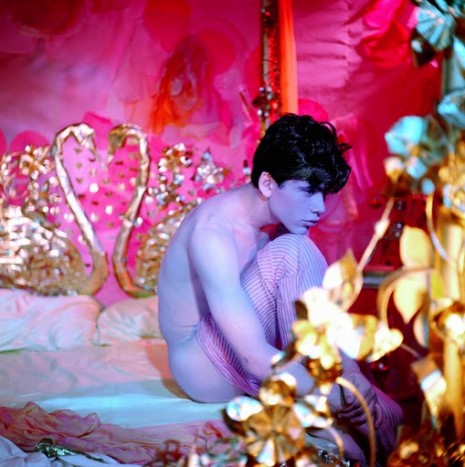
The film was credited to ‘Anonymous’, which led some to think it was by Andy Warhol. Or perhaps Kenneth Anger. The mix of kitsch and beautiful imagery pointed to both. However, they were wrong. For years no one knew who had made Pink Narcissus. This was until the writer Bruce Benderson became obsessed with this subversively erotic film and decided to track down its director - James Bidgood.
Shot on Super-8, Pink Narcissus is a sumptuous film depicting the erotic fantasies of a gay male prostitute (Bobby Kendall), who visualizes himself in various homage to “gay whack-off fantasies”.
Bidgood arrived in New York in 1951. He worked as a female impersonator, hairdresser, set designer and then photographer. Bidgood started taking pix for Adonis and Muscleboy. At first he was disappointed with the results. He told the New York Times:
“There was no art,” Bidgood laments. “They were badly lit and uninteresting. Playboy had girls in furs, feathers and lights. They had faces like beautiful angels. I didn’t understand why boy pictures weren’t like that.”
Bidgood made his own erotic tableaux, which mixed beauty and kitsch. His first Watercolors presented a young man swimming through a fabulous, shimmering grotto—which he built and photographed in his cramped apartment. He told Butt magazine:

“Models were not that easy to find especially for the kind of work I was doing which called for more of the subject’s time than a pose or two wearing less than two square inches of jersey and some elastic and leaning against some fagelas elaborate mantelpiece. In the time I needed to do one shot they could turn ten tricks. And there weren’t all that many great beauties around willing to be photographed nude or semi nude in homoerotic situations. Remember this was before being gay and/or being a ‘male escort’ or pornography, quasi or otherwise, were as acceptable or mainstream as they are now.”
Bidgood created his own distinct style, which later inspired the careers of Pierre et Giles, and David La Chappelle.

Between 1963 and 1971, Bidgood worked on Pink Narcissus. It was shot in his Hell’s Kitchen apartment. Bidgood designed and made the sets, provided the make-up and costume, and used the neighborhood hustlers as his cast. It was an incredible undertaking, and one that eventually led his frustrated backers to take the film from Bidgood and finish it themselves. This was why Bidgood took his name off the finished film.
“See, why I took my name off of it was that I was protesting, which I’d heard at the time that’s what you did…. I’d take my name off and then they’d go “Mr. Bidgood took his name off because…” But it turns out they kept me in the closet, and all you had to do was ask anybody who’s been in it and they’d say, you know, “Jim did this.” It wasn’t like a big mystery, but you would have thought, and then years later I was ‘outed’.”
Previously on DM
Early Gay Cinema: Jean Genet’s ‘Un Chant d’Amour’

Ian McKellen recites a Shakespeare sonnet while The Fleshtones zone out in the background at Warhol’s Factory in 1987.
This is one of those things that language can’t encapsulate. Not so much because it’s something wondrous or epic, it’s not. But because it is just so inexplicably Zen… as most inexplicable things are.
Broadcast on MTV as part of the last episode of “Andy Warhol’s Fifteen Minutes” TV program.
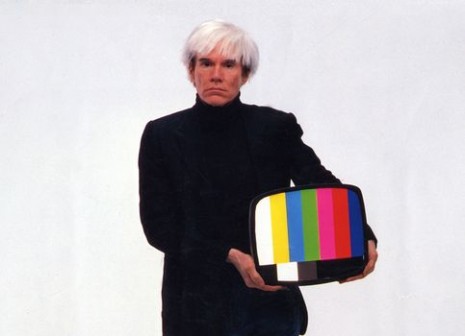
John Waters and Divine appear on Andy Warhol’s cable TV show in 1981. The late Van Smith, make-up and costume designer on Waters’ films, is seen working on Ms. Divine during the interview.
The always amusing Waters talks about his early influences (Herschell Gordon Lewis), his film making style and screens some cool clips from his early movies.
John mentions his book Shock Value which was at the time about to be published. One of my favorite memories is the day that he and Divine signed my copy at a bookstore in Greenwich Village. Two of the classiest trash mavens I’d ever met.
Part two after the jump…
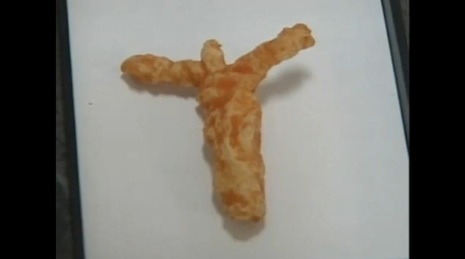
I’d be hard pressed to arrive at a more apt or truly American form for the good lord to take.
Thanks Jimi Hey !
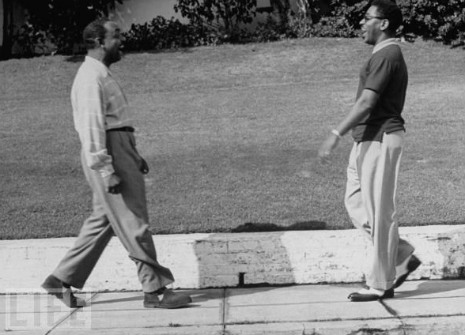
Bebop jazzmen Dizzy Gillespie and Benny Carter are greeting each other with
“Bell man! where have you been?”
Dizzy Gillespie and Benny Carter demonstrate the art of the bebop greeting as featured in Life magazine, October 11, 1948.
The bebop greeting is an esoteric jazz tradition going back to the bop dens of ancient Egypt (home of the Pharaoh of Sanders). Initiates have passed these bebop handshakes, mudras and mantras down over the centuries and they were a highly kept secret until revealed in the mid-twentieth century by unscrupulous jazzbos who clearly had no understanding of the old ways. The bebop greetings Benny and Dizzy are demonstrating in these photos are not authentic bebop ritual. If they were, both men would be subject to immediate elimination by the society of jazzassassins, a ninja-like organization originated by Rahsaan Roland Kirk and formerly known as the saxassassinators.

Dizzy and Benny are giving the shout “Eel-ya-da” which sounds like
bebop triplet notes.
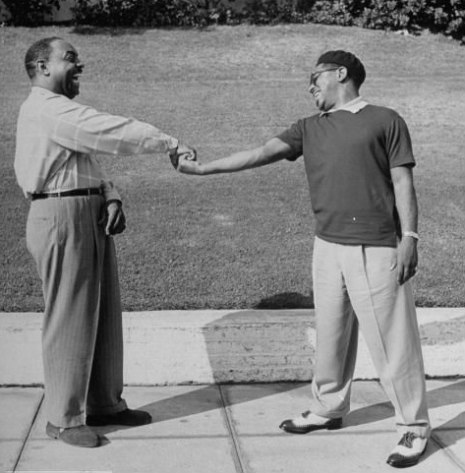
The connection is made.
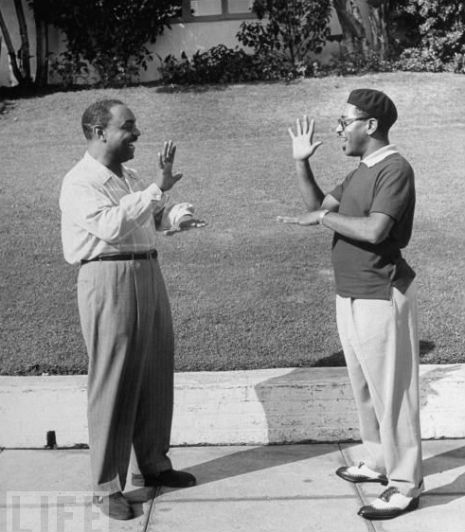
“Later. Keep it cool”
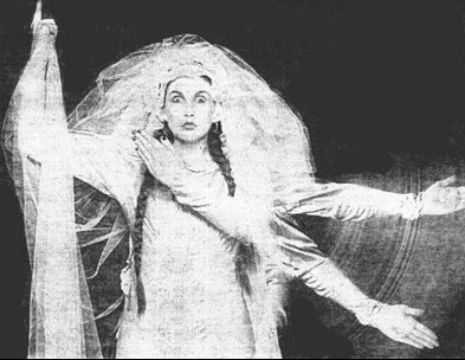
Lene Lovich live at Studio 54 in 1981. Thomas Dolby on synthesizer.
The sound lacks punch, but there’s not much live performance footage of Lene out there and this is better than most.
The set consists of 11 tunes including “New Toy,” “Angels,” “Home,” and of course “Lucky Number.” This was one of the first live shows ever at Studio 54.
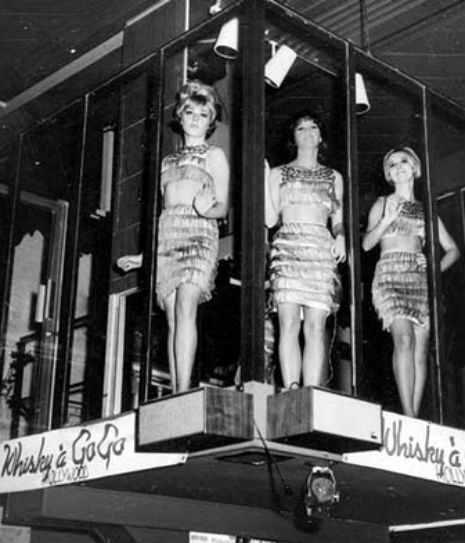
The wild world of dancing to recorded music, the discotheque! The newest dance sensations today are the Frug, the Watusi, the Dog, Swim, Bird and the Mosquito.
The bizarre concept of phoning in your dance requests must have been a Chicago phenomenon and a short lived one. Today’s world is perfect for reviving this idea: tweet a dancer and request the Mosquito or the Bird. Now that would be groovy.
Music by The Squires.

April Fool’s Day 1998, David Bowie hosted a party, at Jeff Koon’s studio in Manhattan, for the launch of William Boyd’s biography of the Abstract Expressionist painter, Nat Tate. As Boyd describes in Harper’s Bazaar, the book, Nat Tate: An American Artist: 1928—1960 was, :
...full of photographs and illustrations, and it was written by [William Boyd]. Nat Tate was a short-lived member of the famous New York School, which flourished in the late 1940s and 1950s and included such luminaries as Jackson Pollock, Franz Kline, and Willem de Kooning. Tate committed suicide in 1960 by jumping off the Staten Island Ferry (his body was never found) after having burned 99 percent of his life’s work during the last weekend of his life.
It was a coup for the author Boyd to have uncovered this forgotten and ignored artist. He gave interviews to the major dailies, the BBC and alike, and had extracts serialized in the Sunday Telegraph. All well and good, except, Nat Tate had never existed, and Boyd’s book was a hoax.
When I first heard about Nat Tate, from keen researchers suggesting a possible doc, it struck me as bogus. I thought this for two reasons: firstly, I’d just read a weighty tome on Jackson Pollock, which made no mention of this genius Tate. Secondly, and more importantly, it was the name Nat Tate, which sounded more like a Folk singer or a Blues percussionist than a painter. Nat Tate is overly familiarly, and moreover, if he had been an Abstract Expressionist, it would have been Nathaniel Tate, as de Kooning was William and not Bill. Smart ass, maybe, but you see, I’d been regularly writing hoax letters to newspapers under various names (Elsie Gutteridge (Mrs)., Edna Bakewell, Ian M. Knowles, The Reverend Desmond Prentice, Richard Friday and Bessie Graham) since I was a 12, and if these seemed hollow to the ear, then, for me, Nat Tate just didn’t ring true.
Okay, my quibbling dickheadery aside, Boyd had worked hard on making Tate “real”, as he told Jim Crace in the Guardian last year:
“I’d been toying with the idea of how things moved from fact to fiction,” says Boyd, “and I wanted to prove something fictive could prove factual. The plan had been to slowly reveal the fiction over a long period of time, but it didn’t really work like that.”
It took Boyd a couple of years to construct Tate’s persona. It wasn’t so much the framework – the reclusive genius who, conveniently, destroyed almost all of his own work and who killed himself at the age of 32 in 1960 – as the details that took the time. “Much of the illusion was created in the details, the footnotes and in getting the book published in Germany to make it look like an authentic art monograph,” he says.
“I went to a lot of trouble to get things right. I created the ‘surviving’ artworks that were featured in the illustrations and spent ages hunting through antique and junk shops for photos of unknown people, whom I could caption as being close friends and relatives.”
It was a good literary hoax, reminiscent of playwright and artist, John Byrne‘s faux naif painter, Patrick, who Byrne created after he failed to sell his own paintings to London galleries during the 1960s. Byrne claimed Patrick was his father, a self-taught artist, whose his fake paintings proved so successful with critics and cognescenti, they led to a major London show, and a memorable commission from The Beatles.

Boyd went further with his creation, as he managed to get David Bowie, Gore Vidal and Picasso’s biographer, John Richardson, in on the act.
“None of them needed much persuasion,” Boyd laughs, “and they all went further that I would have dared ask them. Bowie gave a quote for the front jacket that Tate was one of his favourite artists and that he owned one of his few surviving works.
“Vidal allowed himself to be quoted in the book saying, ‘Tate was essentially dignified, though always drunk and with nothing to say,’ while Richardson told of how Tate had been having lunch with Picasso when he came to visit. It was these details that made it. People stopped wondering why they hadn’t heard of Tate when Vidal, Picasso and Richardson started appearing.”
The best was saved till last. At the launch party for the book at Jeff Koons’ studio in Manhattan, David Lister, the then arts editor of the Independent who was also in on the hoax, spent the evening asking guests what they remembered about Tate. A surprising number seemed to have attended one of his rare retrospectives in the late 60s and everyone lamented how sad they were he had died so young.
The hoax was so good, in fact, that Lister couldn’t stop himself from letting everyone know. “I was pissed off,” says Boyd, “because we had the London launch planned for the following week at a trendy restaurant called Mash, and we were going to repeat the experiment. I’d already done a large number of interviews with British radio, TV and print journalists – who shall remain nameless – and they’d all been taken in. But by the time their copy appeared they all swore blind they knew it was a hoax.
But Boyd’s point was made. And weirdly Tate continues to have a meta-life more real than the rest of us. Tate has now been the subject of three documentaries and has made a walk-on appearance in another fictional memoir, Boyd’s Any Human Heart. His art also lives on. “It’s strange,” says Boyd, “because whenever a friend gets married I always seem to find another Tate in the attic. I’m almost tempted to take one along to Christie’s and see what it sells for.” And most of us would love to buy one. Because some things are too good not to be true.
Boyd writes about the Nat Tate hoax in this month’s Harper’s Bazaar.